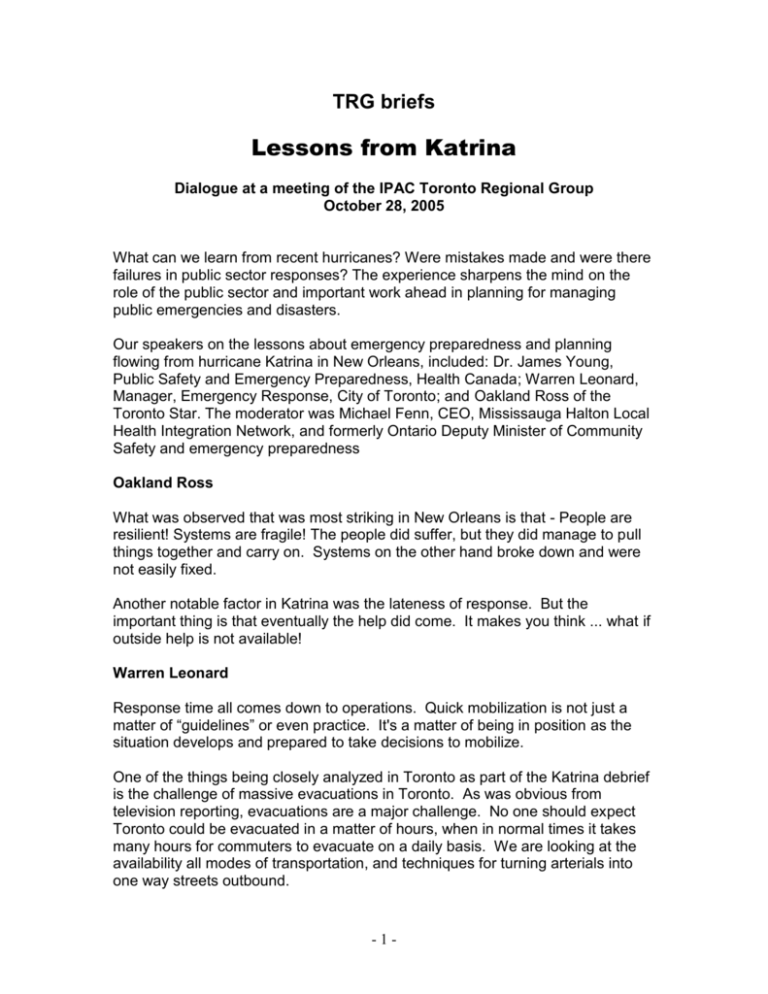TRG briefs
advertisement

TRG briefs Lessons from Katrina Dialogue at a meeting of the IPAC Toronto Regional Group October 28, 2005 What can we learn from recent hurricanes? Were mistakes made and were there failures in public sector responses? The experience sharpens the mind on the role of the public sector and important work ahead in planning for managing public emergencies and disasters. Our speakers on the lessons about emergency preparedness and planning flowing from hurricane Katrina in New Orleans, included: Dr. James Young, Public Safety and Emergency Preparedness, Health Canada; Warren Leonard, Manager, Emergency Response, City of Toronto; and Oakland Ross of the Toronto Star. The moderator was Michael Fenn, CEO, Mississauga Halton Local Health Integration Network, and formerly Ontario Deputy Minister of Community Safety and emergency preparedness Oakland Ross What was observed that was most striking in New Orleans is that - People are resilient! Systems are fragile! The people did suffer, but they did manage to pull things together and carry on. Systems on the other hand broke down and were not easily fixed. Another notable factor in Katrina was the lateness of response. But the important thing is that eventually the help did come. It makes you think ... what if outside help is not available! Warren Leonard Response time all comes down to operations. Quick mobilization is not just a matter of “guidelines” or even practice. It's a matter of being in position as the situation develops and prepared to take decisions to mobilize. One of the things being closely analyzed in Toronto as part of the Katrina debrief is the challenge of massive evacuations in Toronto. As was obvious from television reporting, evacuations are a major challenge. No one should expect Toronto could be evacuated in a matter of hours, when in normal times it takes many hours for commuters to evacuate on a daily basis. We are looking at the availability all modes of transportation, and techniques for turning arterials into one way streets outbound. -1- The local resources available within the city would become exhausted at some point in a disaster, and the city would expect external help from the province and the federal government. As a result of Katrina FEMA is pre-positioning vast resources of trailers full of phones, water, ice, tents, blankets etc. around the country. We're very glad to see that. It is the right kind of preparation. "Stuff" (supplies) is really important in the heat of an emergency; money is not so useful. We are continuing to debrief on Katrina and Wilma, and subsequent major emergencies still going on. Dr. Jim Young People are resilient, and Canadians do seem rise to the occasion, as was seen also as people in the Far East dealt with the tsunami and earthquakes. But this is not a universal response - as Katrina demonstrated. Early warnings can help considerably, if heeded, in responding to emergencies. The simplest things like weather forecasts or geological forecasts etc. give you time to gear up response readiness. The news reporting in New Orleans implied there were unexpected infrastructure failures. In fact the dikes performed according to specification, and perhaps better than specification. They were designed to resist category 3 storms, and they did that. The trouble is the difficulty in getting political support for investing in rare threats, or even in long term strategic planning such as where development will be allowed or not allowed. There will be related difficult political decisions now in New Orleans in making decisions about where to rebuild, and whether to build to better standards, as mitigation against future hurricanes. The bottom line is if you don't spend on mitigation (e.g. storm resistant standards of construction, and forbidding occupation of vulnerable areas – like flood zones), then you will spend on response. The U.S. is now focusing on an "all hazards approach", as Canada has been doing. This makes it somewhat easier to gain support for spending on preparedness. The U.S. was able to mobilize a military response quite quickly and effectively. The Canadian military could not respond like the. But a military response is not the best way to go anyway. FEMA is a better approach, and that is the kind of approach being developed in Canada. -2- The bottom line is that government must respond, and it must respond right from the beginning, not as a subsequent contingency. It's essential that all three levels of government get together and plan, so that everyone is involved right from the beginning. Communication is the key in every emergency. In every emergency there are communication breakdowns. There are simple ways to prepare for these breakdowns - such as prearranged alternative worksites for the emergency workers. Families can help by prearranging outside locations and relatives to serve as communication hubs, when the communications systems breakdown in the city Dialogue Q. Politics present significant barriers to long-term investments and planning. Would it be better to move Emergency Management outside of government, and away from such limitations. A. This has long been an interesting and attractive proposition, but I have been against it on two grounds: Getting financially stranded, and Getting isolated, with the barriers to government and financing increasing in height rather than decreasing A. As a consequence of the rash of disasters and emergencies over the last few years, it is getting easier to gain attention within government. The term "cost of regret" is a good term to use in the political sphere. A. The public is very receptive right now to disaster planning. This makes good political currency Q. I was shocked at the degree of conflict in Katrina between the mayor, the governor and president etc. A. Work ahead of time on joint planning and then on joint exercises to get people acquainted. Get all players sensitive to what the issues and challenges are, before being caught up in the heat of an emergency. Liaison offices help. It helps that the leadership has buy in, like the mayor's office. A. The industrial and private sectors must also prepare, for their own operations, taking into consideration their whole supply chain vulnerabilities as well. - Murray Lister -3-







